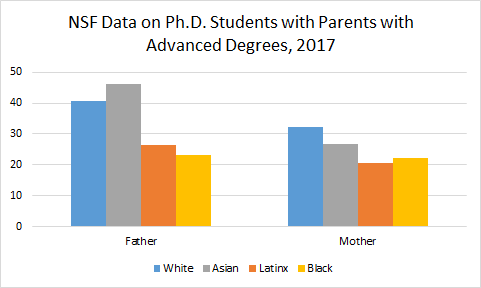You have /5 articles left.
Sign up for a free account or log in.
How many publications does a Ph.D. candidate need to land a tenure-track job at an elite university today?
According to John Robert Warren, in the field of sociology, twice as many as those who were hired in the 1990s. The same inflated requirements apply for securing tenure.
While Warren notes that growing pressure on junior professors to publish, publish, publish “may aggravate inequalities,” this trend represents much more: it is evidence of racial inequity in hiring and promotion in academe. As late entrants to higher education, compared to their white counterparts, racial minority faculty members are disadvantaged by the recent trend toward rising publication requirements for hiring and promotion -- especially with the additional demands often made on their time and energy by mentoring and service work.
Although still underrepresented in tenure-track jobs, racial minorities are entering academic positions in growing numbers due to an increase in the racial and ethnic diversity of doctoral students and higher education institutions’ sustained efforts to hire racially diverse faculty. The number of Ph.D.s has grown since the 1970s, including a significant increase in nonwhite Ph.D. recipients. According to data from the National Science Foundation, between 1975 and 2017, the total number of Ph.D. recipients jumped by 67 percentage points -- from almost 33,000 individuals to almost 55,000. And that growth was driven not by an increase in white recipients, but by an increase in nonwhite ones. Between 1975 and 2017, Asian Ph.D. recipients increased by 3,919 percent, Latinx recipients by 766 percent and black recipients by 179 percent.
Thus, while nonwhite Ph.D.s are still a minority today, the face of newly minted Ph.D.s has changed dramatically -- from overwhelmingly white in 1975 (72 percent of all recipients), to 52 percent white, 26 percent Asian, 7 percent Latinx and 5 percent black in 2017.
Among all Ph.D. recipients, more than half of white, Latinx and black graduates took jobs in academe in both tenure-track and non-tenure-track positions. Assuming a similar proportion of those academic jobs were tenure track in 2017 as they were in 2013, about 8 percent of the black and Latinx graduates took tenure-track positions in higher education, while 7 percent of white graduates did. That corresponds to about 1,900 white, 250 Latinx and 190 black tenure-track faculty members.
White Ph.D.s are still the majority of those entering tenure-track positions, but as these trends demonstrate, the number of nonwhite Ph.D. recipients taking academic jobs increased significantly. And because of their later access, black, Latinx and Asian professors are disproportionately entering academe just as publication standards and expectations to secure tenure-track jobs are rising. Such increases in standards and expectations disadvantage racial and ethnic minority faculty, given that white faculty, as a group, entered academic jobs when the expectations for hiring and promotion were comparatively lower. This trend in academe mirrors similar ones in other areas. Just as job security and benefits declined in manufacturing and postal occupations in the 1960s when black workers entered these industries, nonwhites today are confronting historically less favorable conditions in academe.
Faculty members of color face other disadvantages that their white colleagues don’t experience. First, the growing number of students of color and the continued underrepresentation of nonwhites as tenure-track faculty in higher education means that nonwhite faculty must respond to much greater student demands for mentoring, role modeling and counseling than their white colleagues do -- particularly around issues of race and racism on campuses. Second, nonwhite faculty members report that to be seen as “legitimate” scholars, they must do more emotional work interacting with their colleagues around research. Almost three-quarters of black, Asian and Latinx professors reported “feeling a need to work harder than their colleagues to be seen as legitimate scholars,” compared to less than half of white professors. The work involved in supporting and mentoring students, legitimizing one’s research, and navigating ethno-racial microaggressions is part of the “invisible labor” that most colleges and universities do not recognize in the tenure and promotion process.
These inequalities in work demands exist within a social system that is also unequal due to racial differences in educational access and attainment. Nonwhite Ph.D.s are less likely than their white counterparts to have family or friends with doctorates who can advise and support them through the processes of hiring, tenure and promotion. White Ph.D. students are more likely to have a parent with an advanced degree than their nonwhite peers, which one report identified as the strongest influence on whether an individual entered a doctoral program.
Among Ph.D. students in 2017, 46 percent of Asians and 41 percent of whites had a father with an advanced degree, compared with just 27 percent of Latinx and 23 percent of black students. While these figures include any degree higher than a bachelor’s, the national trends suggest the differences between Ph.D. students with at least one parent who holds a Ph.D. and those without such a parent are likely to be significant. Only 1 percent of black and 0.7 percent of Latinx children nationwide had a parent with a Ph.D. in 2017, compared with 2.7 percent of white children and 6.8 percent of Asian children. Because social networks in the United States are highly segregated, this means that black and Latinx Ph.D. students and assistant professors are not only less likely to have a parent with a Ph.D. but also less likely to know someone with a doctorate than their white and Asian counterparts. (The higher proportion of Asian Ph.D.s whose parent holds a Ph.D. reflects an influx of higher-educated Asian immigrants since the 1990s and point to a growing divide among those first- and second-generation Asians, the children of low-income refugees, and long-standing Asian Americans.)
 In general, white-nonwhite differences reflect racial disparities in access to and completion of college education. And, all in all, such differences suggest that white Ph.D. recipients entering tenure-track jobs probably have more special insight into the tenure and promotion process, the culture of an academic work environment and even social connections in tenure-track jobs than their nonwhite peers.
In general, white-nonwhite differences reflect racial disparities in access to and completion of college education. And, all in all, such differences suggest that white Ph.D. recipients entering tenure-track jobs probably have more special insight into the tenure and promotion process, the culture of an academic work environment and even social connections in tenure-track jobs than their nonwhite peers.
The early access and entrée to doctoral programs and tenure-track positions that whites have traditionally enjoyed means not only that a predominantly white group entered academe with lower standards, but also that those tenured white faculty have been able to pass on knowledge and insight about publishing, getting an academic job and achieving tenure to their children who are now pursuing Ph.D.s. While all new tenure-track faculty members are being held to higher expectations, nonwhite faculty are attempting to meet those standards with more demands on their time and less insight into the tenure process through their social contacts. In this racially skewed workplace, higher publication expectations make nonwhites more disadvantaged in hiring and tenure promotion.
Colleges and universities can begin to address these racial inequalities through a few approaches. First, they should acknowledge the invisible labor nonwhite faculty members perform in the tenure and promotion process as a signal of their involvement and commitment to the department. Second, they should offer support and mentorship for nonwhite faculty members at all levels of promotion, not just for assistant professors. Third, they should provide institutional advising, counseling and other support for underrepresented students to reduce the demands on nonwhite faculty. And finally, acknowledging the increased demands on nonwhite faculty, they should hire more of them. While these solutions will not produce an even playing field, they will create a more level starting point for evaluation.




